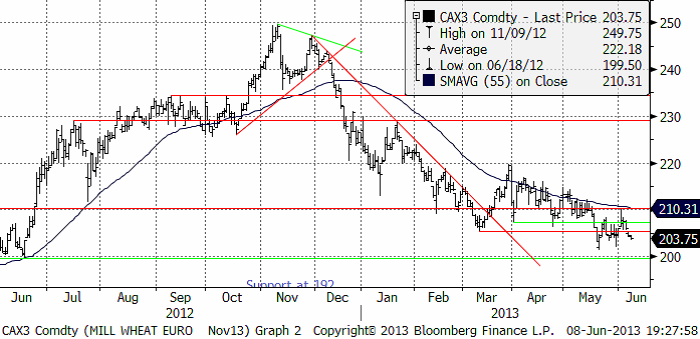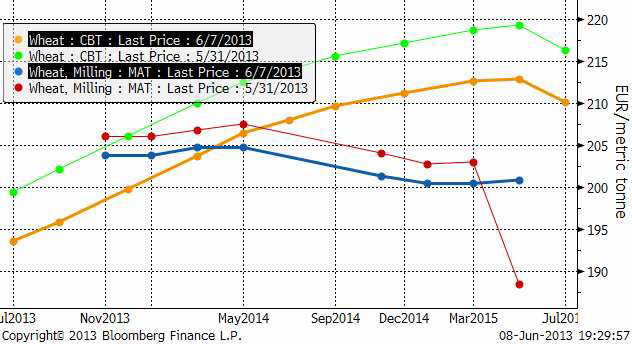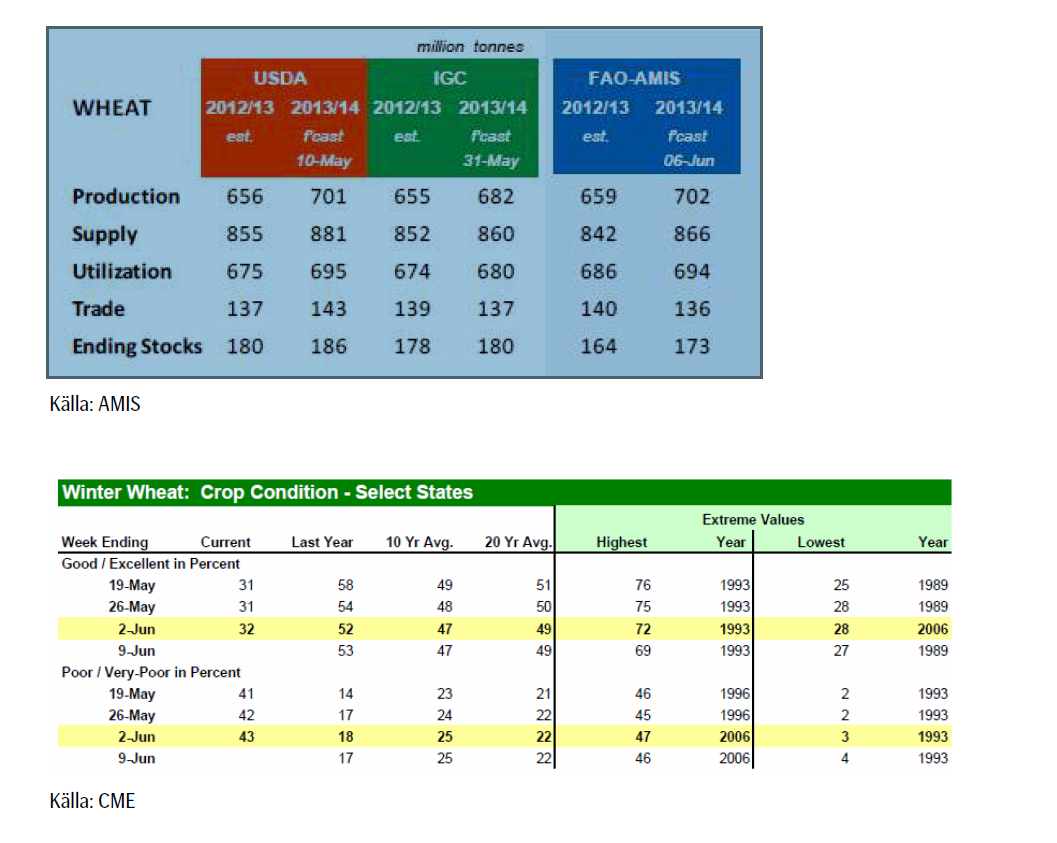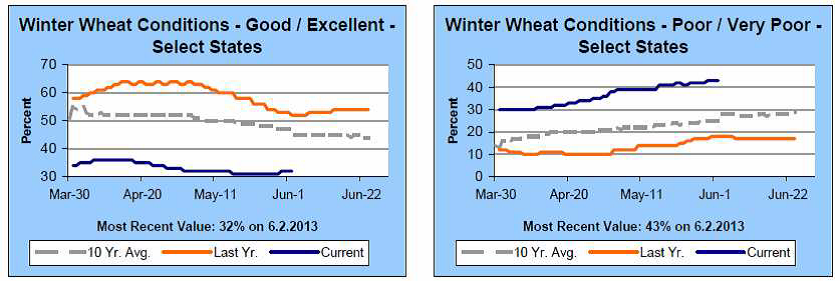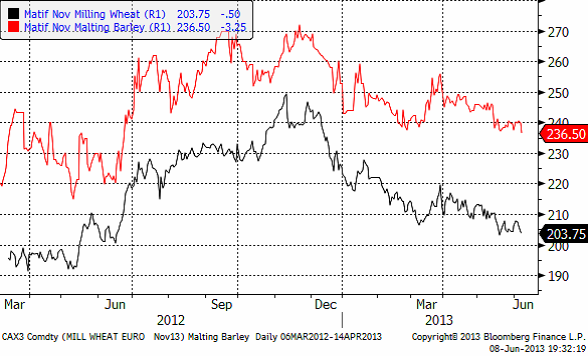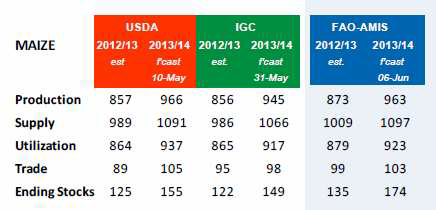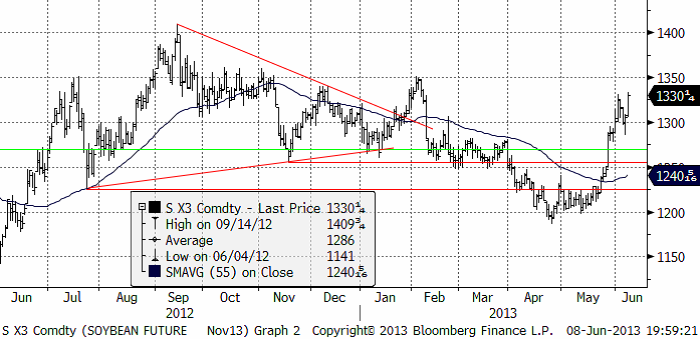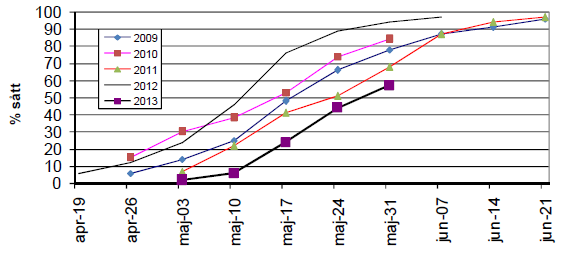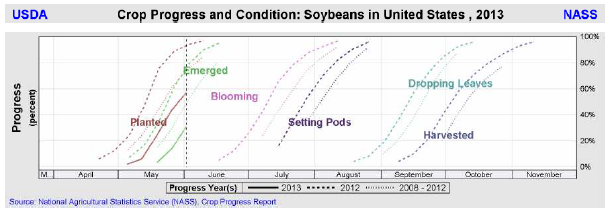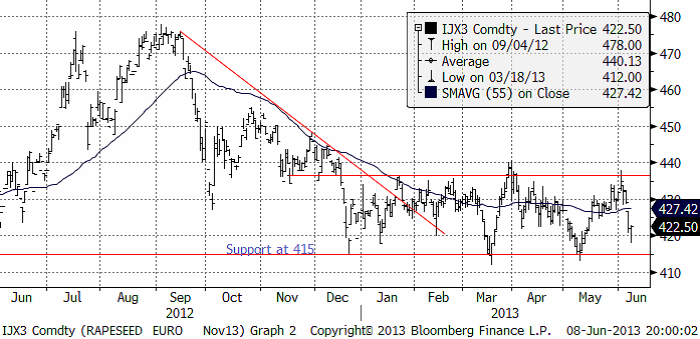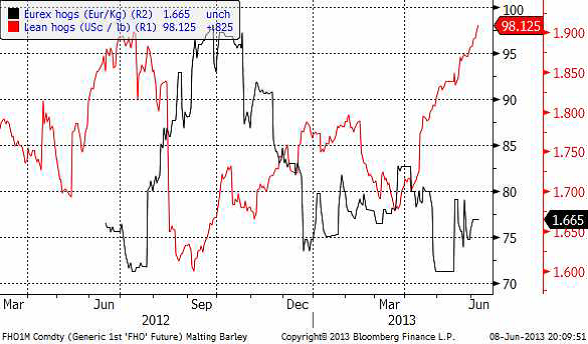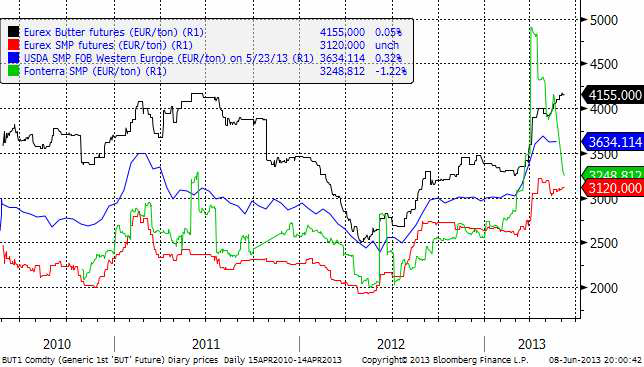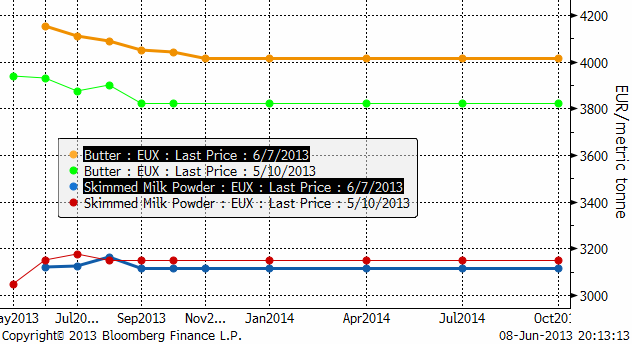Analys
SEB Jordbruksprodukter, 10 juni 2013
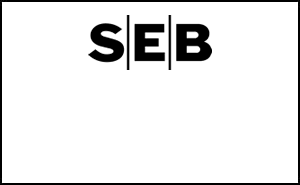
 Priset på vete har gått ner något på Matif i veckan. Sojabönor har stigit ganska mycket, men ligger precis under ett tekniskt motstånd. Rapspriset på Matif gick i motsatt riktning. Den främsta förklaringen är att medan vädret är ogynnsamt för sojabönorna i USA, är det gynnsamt för rapsen i Europa och framförallt i Kanada. Grispriserna går åt helt olika håll i världen. Medan priset på den tyska Eurex-börsen är nära tvåårslägsta, har Lean Hogs noterat tvåårshögsta i Chicago. Fonterra-noteringen har fortsatt att falla, men priset på SMP har hållit sig stabilit på Eurex, samtidigt som terminspriset på smör stigit.
Priset på vete har gått ner något på Matif i veckan. Sojabönor har stigit ganska mycket, men ligger precis under ett tekniskt motstånd. Rapspriset på Matif gick i motsatt riktning. Den främsta förklaringen är att medan vädret är ogynnsamt för sojabönorna i USA, är det gynnsamt för rapsen i Europa och framförallt i Kanada. Grispriserna går åt helt olika håll i världen. Medan priset på den tyska Eurex-börsen är nära tvåårslägsta, har Lean Hogs noterat tvåårshögsta i Chicago. Fonterra-noteringen har fortsatt att falla, men priset på SMP har hållit sig stabilit på Eurex, samtidigt som terminspriset på smör stigit.
På onsdag är det dags för WASDE-rapport igen. Några av Bloombergs analytiker-estimat för de mest centrala posterna finns redan att notera inför onsdagen. Du ser dem i nyhetskalendern längre ner i det här brevet.
MARS
 EU Kommissionens MARS-enhet gjorde en marginell justering nedåt i sin senaste rapport gällande den genomsnittliga avkastningen för vete, majs och oljeväxter medan en marginell justering uppåt gjordes för korn. Varmare temperaturer i bl.a västra Europa har fått fart på grödornas utveckling efter den kalla våren, även om det fortfarande finns märkbara fördröjningar gällande höstgrödorna – framförallt i Storbritannien men även i Benelux länderna – men överlag så kvarstår de nuvarande utsikterna för EU-27 i stort sett i linje med genomsnittet.
EU Kommissionens MARS-enhet gjorde en marginell justering nedåt i sin senaste rapport gällande den genomsnittliga avkastningen för vete, majs och oljeväxter medan en marginell justering uppåt gjordes för korn. Varmare temperaturer i bl.a västra Europa har fått fart på grödornas utveckling efter den kalla våren, även om det fortfarande finns märkbara fördröjningar gällande höstgrödorna – framförallt i Storbritannien men även i Benelux länderna – men överlag så kvarstår de nuvarande utsikterna för EU-27 i stort sett i linje med genomsnittet.
Prognosen för EU-27’s vete justerades ner till 5.54 t/ha från förra månadens 5.63 t/ha, vilket fortfarande är en ökning med 2.3% jämfört med förra året men strax under det femåriga genomsnittet på 5.63 t/ha. Detta som en följd av indikationer om lägre avkastning i Storbritannien och Irland där grödorna ligger ca 2-3 veckor efter i sin utveckling samt i Baltikum, Ungern, Tjeckien, Polen och Danmark. Estimatet för Storbritannien justeras ner från 8.02 t/ha till 7.68 t/ha då grödorna har blivit hårt drabbade av förra årets rekordregn, som påverkade förra årets skörd och sådden av årets grödor.
Estimatet för EU-27’s majs reviderades ner från förra månadens 6.96 t/ha till 6.87 t/ha, som dock är en ökning med 16.3% sedan 2012. Norra Italien har drabbats av kraftiga regn under maj månad vilket har försenat sådden av majs. MARS lämnar dock sin prognos för Italien oförändrad för nu, med reservationer för revideringar i avkastningen nedåt framöver. Prognosen för korn justerades däremot upp och ligger nu på 4.56 t/ha, en ökning från förra månadens 4.48 t/ha. Framförallt görs en rejäl uppjustering av höstkorn i Spanien med 25% medan marginella justeringar nedåt görs för t.ex Tyskland och Frankrike. Även avkastningen för vårkorn justeras upp med nästan 4%, också detta på grund av gynnsamma utsikter i Spanien.
Avkastningen för raps och rybs justeras ner marginellt från 3.09 t/ha till 3.06 t/ha då utsikterna för Storbritannien, Rumänien, Ungern och Slovakien har försämrats och inte kompenseras av revideringen uppåt för Polen och den marginella förbättringen i Tyskland.
Vete
Priset på novemberterminen på Matif föll till 203.75 euro per ton i veckan som gick. Detta trots att Egypten bett Frankrike om hjälp med spannmålsförsörjning, lagring och finansiering av detta, översvämningar i östra Tyskland och att EU-Kommissionen sänkt skördeestimatet med 2 mt till 127.9 mt. Trots allt är det en större skörd än förra årets 123.8 mt.
Decemberkontraktet på CBOT har inte visat stora tecken på att vilja gå ner. 700 cent utgör ett starkt stöd, liksom 758 cent ovanför utgör ett motstånd. Just nu och de kommande dagarna ser det ut att finnas möjlighet till ytterligare prisnedgång, ner mot 700 cent kanske och ett test av den nivån.
Nedan ser vi förändringen i terminskurvorna fredag till fredag. Vi ser att Matifs terminsmarknad har sjunkit betydligt mer än den amerikanska.
IGC justerar upp sin prognos för den globala produktionen av vete 2013/14 med 2 mt till 682 mt, en ökning med 4% på årsbasis till följd av högre areal och avkastning, men justerar samtidigt upp sitt estimat för den globala konsumtionen med 2 mt till 680 mt.
FAO-AMIS säger att den globala veteproduktionen 2013/14 förväntas slå rekord och justerar upp sitt estimat till 702 mt, en ökning på 6.5% på årsbasis, på förväntningar om en återhämtning i Europa och Svarta Havsregionen . Konsumtionen förväntas öka med 1.1% där användningen av foder förväntas återgå till mer normala nivåer medan livsmedelskonsumtionen fortsätter att hålla jämna steg med befolkningstillväxten.
Måndagens Crop Progress rapport från USDA visar på marginella förändringar för det amerikanska höstvetet. För de 18 stater som rapporterar så klassas 32% som ”good/excellent”, upp 1% från förra veckan men väl under förra årets 52% vid samma tid. Höstvete klassat som ”poor/very poor” uppgår till 43%, också det en ökning med 1% från förra veckan och väl över förra årets 18% vid samma tid. Andelen höstvete som har gått i ax fortsätter dock att ligga under genomsnittet, både i de HRW och i de SRW producerande staterna, som en följd av den kalla våren. Per den 2 juni hade 73% gått i ax, vilket är att jämföra med förra årets 88% vid samma tid och det femåriga genomsnittet på 80% vid denna tidpunkt.
Sådden av vårvete i de 6 största staterna gjorde små framsteg i veckan som gick och är nu avklarad till 80%, upp endast 1% från vecka innan och fortfarande efter förra årets 100% och det femåriga genomsnittet på 92%.
Den största producenten, North Dakota, ligger fortfarande sist med endast 64% av sådden avklarad, jämfört med dess femåriga genomsnitt på 89% vid den här tiden. Rapporten visade också för första gången tillståndet för vårvetet, varav 8% klassas som ”poor/very poor”, medan 64% klassas som ”good/excellent” – att jämföra med förra årets 2% resp 78%.
Slutsatsen är att vi behåller vår säljrekommendation på vete.
Maltkorn
Maltkornet höll sig någorlunda starkt i veckan, men om vetet fortsätter ner, får vi nog se ett nedställ på maltkornet också. Trenden är tydligt nedåtriktad.
Majs
Majspriset (december 2013) har liksom vetet fått stöd den senaste tiden. Efter årslägsta notering i slutet av maj har priset stigit kraftigt uppåt, rekylerat ner och i fredags börjat ett nytt försök uppåt. Än så länge rör sig priserna under den nivån som uppnåddes innan plantings-rapporten från USDA i slutet av mars, men ett test av den nivån kan komma och i så fall kan priset nå ändå upp mot 600 cent. Det vore verkligen ett ödets ironi att vad som väntas bli den största skörden någonsin följs av prisuppgång. Fredagens prisuppgång följde på en förnyad prognos om kallt och vått väder i USA.
IGC justerar upp sin prognos för den globala produktionen av majs 2013/14 med 6 mt till rekordhöga 945 mt, en ökning med 89 mt på årsbasis. Samtidigt justeras konsumtionen upp med 5 mt till 917 mt. Utgående lager 2013/14 beräknas dock bli mer komfortabla jämfört med året innan, framförallt i USA där lagren förväntas öka mer än dubbelt från 19.3 mt till 44.8 mt. Globala utgående lager justeras upp med 6 mt till 149 mt.
FAO-AMIS säger att den globala majsproduktionen 2013/14 förväntas öka, främst på grund av en återhämtning i USA, och justerar upp sin prognos till 963 mt – en ökning med 90 mt på årsbasis. Även prognosen för den globala konsumtionen revideras upp med 44 mt till 923 mt, till följd av ökad foderanvändning i USA och ett flertal tillväxtländer. Utgående lager förväntas öka med 29% och återspeglar framförallt högre lager i USA men även Kina, Brasilien och Europa.
Till förra helgen hade amerikanska lantbrukare lyckats ta sig till 91% färdigsått, vilket är den långsammaste takten på 17 år.
Måndagens Crop Progress visar att lantbrukarna fortsätter att göra framsteg vad gäller sådden av majs, vilken också översteg marknadens förväntningar, trots ihållande regn över majsbältet. Som nämnt ovan, var sådden per den 2 juni i de 18 största majsproducerande staterna avklarad till 91%, en ökning från 86% en vecka tidigare men något lägre än det femåriga genomsnittet på 95% vid den här tiden. Vårens kalla och blöta väder över majsbältet har gjort att årets sådd ligger något efter förra årets sådd som var avklarad vid den här tiden.
Rapporten visade också för första gången tillståndet för majs varav 7% klassas som ”poor/very poor”, medan 63% klassas som ”good/excellent” – att jämföra med förra årets 5% resp 72%, innan torkan slog till. Detta är trots allt mycket bra.
Argentina har skördat 61% av sin majs. Sydamerika har en väsentligt större skörd av majs i år än förra året. USA har bara sålt 52,000 ton av ny skörd hittills vilket är ovanligt lite. Det visar att USA har fått ordentlig konkurrens på den globala marknaden för majs.
Slutsatsen är att vi behåller vår säljrekommendation på majs.
Sojabönor
Sojabönorna har rest sig efter att ha alla bevis mot sig. Det kalla och blöta amerikanska vädret är vad som ligger bakom. Tekniskt är 1350 cent på novemberkontraktet ett starkt motstånd, markerat av topp i juli förra året, den övre delen av prisintervallet under oktober och november, en topp i december och en topp i februari.
Det stora köparlandet Kina omvartannat både köper och annullerar ordrar från Sydamerika. De makroekonomiska data som kommer ut från landet, visar en ekonomi som bromsar in. Allt fokus just nu är dock på sådden och vädret. I veckan (förra helgen) var 57% sått, och det var en ökning från 44% för två veckor sedan.
Nedan ser vi såddens utveckling i jämförelse med tidigare år.
Från USDA själva har vi hämtat följande bild:
Sådden är alltså avklarad till 57%, vilket kan jämföras med 93% vid den här tiden förra året och det femåriga genomsnittet på 74%.
I Iowa, den största producenten, är sådden endast avklarad till 44% – vilket är långt efter det femåriga genomsnittet på 91% vid denna tid – samtidigt som sådden hos den näst största producenten, Illinois, nu är avklarad till 49%, en ökning från veckan innan men fortfarande efter det femåriga genomsnittet på 69%.
Marknadens byte av fokus från den stora ökningen av Sydamerikas produktion och den svagare kinesiska efterfrågeökningen, till vårsådden i USA och de väderproblem som drabbat följt slag i slag i USA, har fått en vacker baisse att vändas i en kraftig rekyl uppåt. I det här läget är det för sent att ta några korta köpta positioner. Snart nog kommer fokus att flytta till långsiktiga faktorer igen. De slutliga prövningarna blir det fortsatta vädret under sommaren fram till höstens eventuella frostrapporter.
Slutsatsen är att vi behåller och upprepar vår säljrekommendation på sojabönor.
Raps
Rapspriset (November 2013) håller sig inom det prisintervall som det gjort sedan december. Det blev ett kraftigt prisfall i veckan dels på att Kanadas sådd går framåt och på ett kraftigt prisfall på rapsolja i den asiatiska marknaden. Medan det i USA är dåligt väder, är det mycket gynnsamt väder i Kanada.
Fredagens prisfall på Matif fick bränsle av ett kraftigt prisfall på rapsolja på den asiatiska marknaden. Anledningen är att man är orolig för att Kina ska dumpa olagligt importerad genmodifierad rapsolja på världsmarknaden. Att fredagens prisfall inte blev värre, får nog ändå ses som ett styrketecken i det korta perspektivet.
Gris
Medan priset på gris fallit i snart ett år på den tyska börsen, har priset på Lean Hogs i Chicago gått upp till den högsta nivån på flera år. Lean Hogs och det tyska grispriset har det senaste året gått åt motsatt håll även i de mindre rörelserna.
Mjölk
Fonterra-noteringen har fortsatt att falla och ligger nu bara strax över Eurex terminspris på SMP. Medan SMP sjunkit något även på Eurex, har priset på smör på Eurex fortsatt att stiga.
Nedan ser vi terminskurvorna på Eurex för smör och skummjölkspulver per i fredags kväll och för en månad sedan. Vi ser att terminspriserna på SMP gått ner marginellt, men att priset på smör gått upp en hel del.
[box]SEB Veckobrev Jordbruksprodukter är producerat av SEB Merchant Banking och publiceras i samarbete och med tillstånd på Råvarumarknaden.se[/box]
Disclaimer
The information in this document has been compiled by SEB Merchant Banking, a division within Skandinaviska Enskilda Banken AB (publ) (“SEB”).
Opinions contained in this report represent the bank’s present opinion only and are subject to change without notice. All information contained in this report has been compiled in good faith from sources believed to be reliable. However, no representation or warranty, expressed or implied, is made with respect to the completeness or accuracy of its contents and the information is not to be relied upon as authoritative. Anyone considering taking actions based upon the content of this document is urged to base his or her investment decisions upon such investigations as he or she deems necessary. This document is being provided as information only, and no specific actions are being solicited as a result of it; to the extent permitted by law, no liability whatsoever is accepted for any direct or consequential loss arising from use of this document or its contents.
About SEB
SEB is a public company incorporated in Stockholm, Sweden, with limited liability. It is a participant at major Nordic and other European Regulated Markets and Multilateral Trading Facilities (as well as some non-European equivalent markets) for trading in financial instruments, such as markets operated by NASDAQ OMX, NYSE Euronext, London Stock Exchange, Deutsche Börse, Swiss Exchanges, Turquoise and Chi-X. SEB is authorized and regulated by Finansinspektionen in Sweden; it is authorized and subject to limited regulation by the Financial Services Authority for the conduct of designated investment business in the UK, and is subject to the provisions of relevant regulators in all other jurisdictions where SEB conducts operations. SEB Merchant Banking. All rights reserved.
Analys
Brent crude ticks higher on tension, but market structure stays soft

Brent crude has climbed roughly USD 1.5-2 per barrel since Friday, yet falling USD 0.3 per barrel this mornig and currently trading near USD 67.25/bbl after yesterday’s climb. While the rally reflects short-term geopolitical tension, price action has been choppy, and crude remains locked in a broader range – caught between supply-side pressure and spot resilience.

Prices have been supported by renewed Ukrainian drone strikes targeting Russian infrastructure. Over the weekend, falling debris triggered a fire at the 20mtpa Kirishi refinery, following last week’s attack on the key Primorsk terminal.
Argus estimates that these attacks have halted ish 300 kbl/d of Russian refining capacity in August and September. While the market impact is limited for now, the action signals Kyiv’s growing willingness to disrupt oil flows – supporting a soft geopolitical floor under prices.
The political environment is shifting: the EU is reportedly considering sanctions on Indian and Chinese firms facilitating Russian crude flows, while the U.S. has so far held back – despite Bessent warning that any action from Washington depends on broader European participation. Senator Graham has also publicly criticized NATO members like Slovakia and Hungary for continuing Russian oil imports.
It’s worth noting that China and India remain the two largest buyers of Russian barrels since the invasion of Ukraine. While New Delhi has been hit with 50% secondary tariffs, Beijing has been spared so far.
Still, the broader supply/demand balance leans bearish. Futures markets reflect this: Brent’s prompt spread (gauge of near-term tightness) has narrowed to the current USD 0.42/bl, down from USD 0.96/bl two months ago, pointing to weakening backwardation.
This aligns with expectations for a record surplus in 2026, largely driven by the faster-than-anticipated return of OPEC+ barrels to market. OPEC+ is gathering in Vienna this week to begin revising member production capacity estimates – setting the stage for new output baselines from 2027. The group aims to agree on how to define “maximum sustainable capacity,” with a proposal expected by year-end.
While the IEA pegs OPEC+ capacity at 47.9 million barrels per day, actual output in August was only 42.4 million barrels per day. Disagreements over data and quota fairness (especially from Iraq and Nigeria) have already delayed this process. Angola even quit the group last year after being assigned a lower target than expected. It also remains unclear whether Russia and Iraq can regain earlier output levels due to infrastructure constraints.
Also, macro remains another key driver this week. A 25bp Fed rate cut is widely expected tomorrow (Wednesday), and commodities in general could benefit a potential cut.
Summing up: Brent crude continues to drift sideways, finding near-term support from geopolitics and refining strength. But with surplus building and market structure softening, the upside may remain capped.
Analys
Volatile but going nowhere. Brent crude circles USD 66 as market weighs surplus vs risk

Brent crude is essentially flat on the week, but after a volatile ride. Prices started Monday near USD 65.5/bl, climbed steadily to a mid-week high of USD 67.8/bl on Wednesday evening, before falling sharply – losing about USD 2/bl during Thursday’s session.

Brent is currently trading around USD 65.8/bl, right back where it began. The volatility reflects the market’s ongoing struggle to balance growing surplus risks against persistent geopolitical uncertainty and resilient refined product margins. Thursday’s slide snapped a three-day rally and came largely in response to a string of bearish signals, most notably from the IEA’s updated short-term outlook.
The IEA now projects record global oversupply in 2026, reinforcing concerns flagged earlier by the U.S. EIA, which already sees inventories building this quarter. The forecast comes just days after OPEC+ confirmed it will continue returning idle barrels to the market in October – albeit at a slower pace of +137,000 bl/d. While modest, the move underscores a steady push to reclaim market share and adds to supply-side pressure into year-end.
Thursday’s price drop also followed geopolitical incidences: Israeli airstrikes reportedly targeted Hamas leadership in Doha, while Russian drones crossed into Polish airspace – events that initially sent crude higher as traders covered short positions.
Yet, sentiment remains broadly cautious. Strong refining margins and low inventories at key pricing hubs like Europe continue to support the downside. Chinese stockpiling of discounted Russian barrels and tightness in refined product markets – especially diesel – are also lending support.
On the demand side, the IEA revised up its 2025 global demand growth forecast by 60,000 bl/d to 740,000 bl/d YoY, while leaving 2026 unchanged at 698,000 bl/d. Interestingly, the agency also signaled that its next long-term report could show global oil demand rising through 2050.
Meanwhile, OPEC offered a contrasting view in its latest Monthly Oil Market Report, maintaining expectations for a supply deficit both this year and next, even as its members raise output. The group kept its demand growth estimates for 2025 and 2026 unchanged at 1.29 million bl/d and 1.38 million bl/d, respectively.
We continue to watch whether the bearish supply outlook will outweigh geopolitical risk, and if Brent can continue to find support above USD 65/bl – a level increasingly seen as a soft floor for OPEC+ policy.
Analys
Waiting for the surplus while we worry about Israel and Qatar

Brent crude makes some gains as Israel’s attack on Hamas in Qatar rattles markets. Brent crude spiked to a high of USD 67.38/b yesterday as Israel made a strike on Hamas in Qatar. But it wasn’t able to hold on to that level and only closed up 0.6% in the end at USD 66.39/b. This morning it is starting on the up with a gain of 0.9% at USD 67/b. Still rattled by Israel’s attack on Hamas in Qatar yesterday. Brent is getting some help on the margin this morning with Asian equities higher and copper gaining half a percent. But the dark cloud of surplus ahead is nonetheless hanging over the market with Brent trading two dollar lower than last Tuesday.

Geopolitical risk premiums in oil rarely lasts long unless actual supply disruption kicks in. While Israel’s attack on Hamas in Qatar is shocking, the geopolitical risk lifting crude oil yesterday and this morning is unlikely to last very long as such geopolitical risk premiums usually do not last long unless real disruption kicks in.
US API data yesterday indicated a US crude and product stock build last week of 3.1 mb. The US API last evening released partial US oil inventory data indicating that US crude stocks rose 1.3 mb and middle distillates rose 1.5 mb while gasoline rose 0.3 mb. In total a bit more than 3 mb increase. US crude and product stocks usually rise around 1 mb per week this time of year. So US commercial crude and product stock rose 2 mb over the past week adjusted for the seasonal norm. Official and complete data are due today at 16:30.
A 2 mb/week seasonally adj. US stock build implies a 1 – 1.4 mb/d global surplus if it is persistent. Assume that if the global oil market is running a surplus then some 20% to 30% of that surplus ends up in US commercial inventories. A 2 mb seasonally adjusted inventory build equals 286 kb/d. Divide by 0.2 to 0.3 and we get an implied global surplus of 950 kb/d to 1430 kb/d. A 2 mb/week seasonally adjusted build in US oil inventories is close to noise unless it is a persistent pattern every week.
US IEA STEO oil report: Robust surplus ahead and Brent averaging USD 51/b in 2026. The US EIA yesterday released its monthly STEO oil report. It projected a large and persistent surplus ahead. It estimates a global surplus of 2.2 m/d from September to December this year. A 2.4 mb/d surplus in Q1-26 and an average surplus for 2026 of 1.6 mb/d resulting in an average Brent crude oil price of USD 51/b next year. And that includes an assumption where OPEC crude oil production only averages 27.8 mb/d in 2026 versus 27.0 mb/d in 2024 and 28.6 mb/d in August.
Brent will feel the bear-pressure once US/OECD stocks starts visible build. In the meanwhile the oil market sits waiting for this projected surplus to materialize in US and OECD inventories. Once they visibly starts to build on a consistent basis, then Brent crude will likely quickly lose altitude. And unless some unforeseen supply disruption kicks in, it is bound to happen.
US IEA STEO September report. In total not much different than it was in January
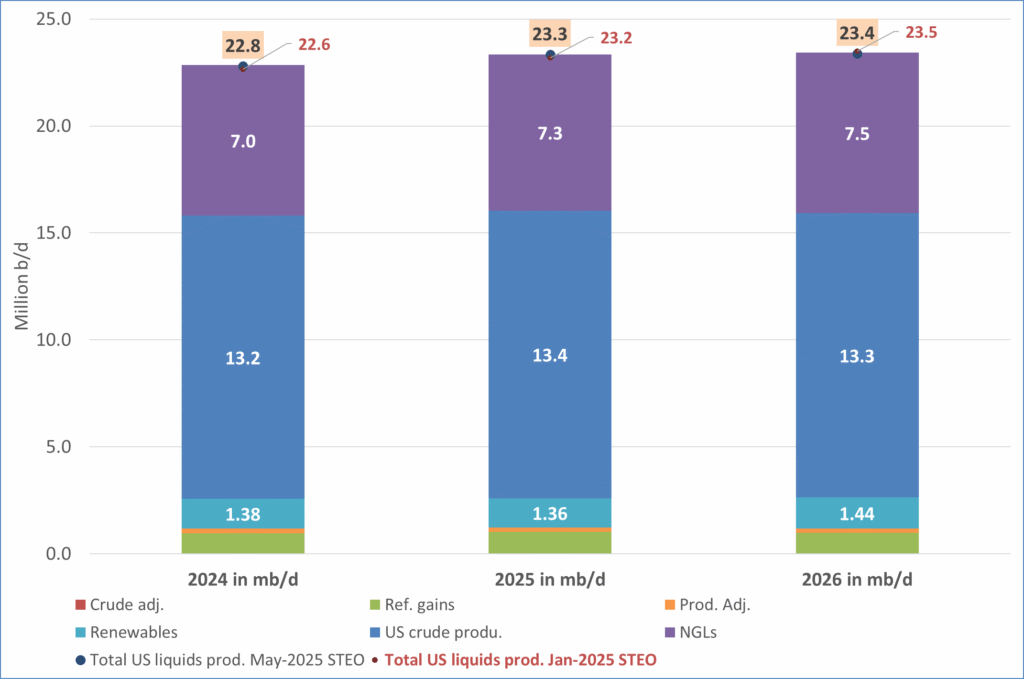
US IEA STEO September report. US crude oil production contracting in 2026, but NGLs still growing. Close to zero net liquids growth in total.

-

 Nyheter4 veckor sedan
Nyheter4 veckor sedanMeta bygger ett AI-datacenter på 5 GW och 2,25 GW gaskraftverk
-
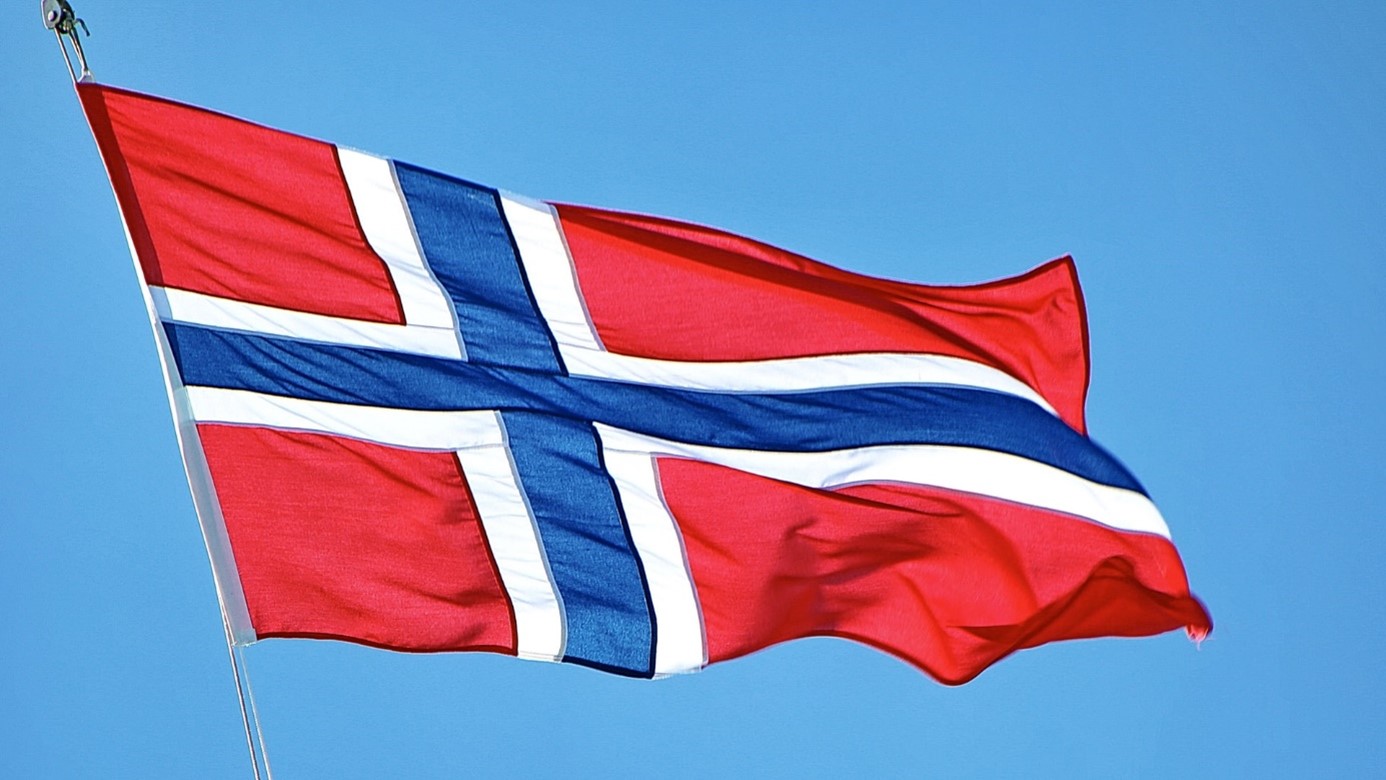
 Nyheter4 veckor sedan
Nyheter4 veckor sedanAker BP gör ett av Norges största oljefynd på ett decennium, stärker resurserna i Yggdrasilområdet
-

 Nyheter4 veckor sedan
Nyheter4 veckor sedanSommarens torka kan ge högre elpriser i höst
-

 Analys4 veckor sedan
Analys4 veckor sedanBrent edges higher as India–Russia oil trade draws U.S. ire and Powell takes the stage at Jackson Hole
-

 Nyheter3 veckor sedan
Nyheter3 veckor sedanMahvie Minerals är verksamt i guldrikt område i Finland
-

 Analys3 veckor sedan
Analys3 veckor sedanIncreasing risk that OPEC+ will unwind the last 1.65 mb/d of cuts when they meet on 7 September
-

 Nyheter3 veckor sedan
Nyheter3 veckor sedanNeil Atkinson spår att priset på olja kommer att stiga till 70 USD
-

 Analys2 veckor sedan
Analys2 veckor sedanOPEC+ in a process of retaking market share



